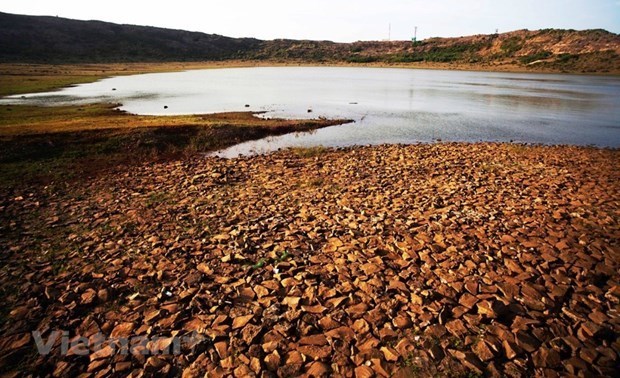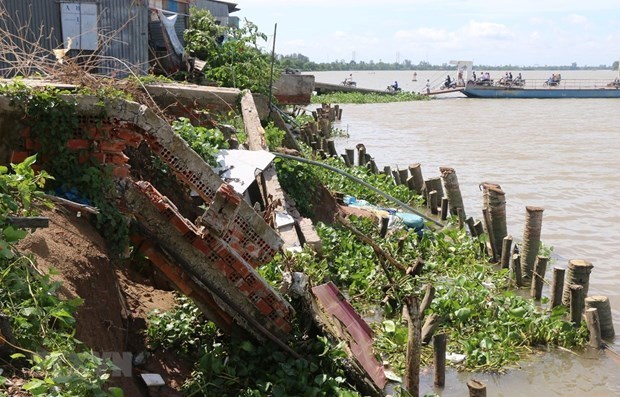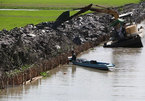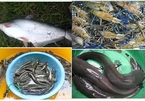 |
|
Subsidence and overexploitation of underground water have been popular in Mekong Delta region |
In the past 25 years, Mekong Delta and the communities, cities and ricefields that depend on it, have faced grave risks of higher tides, alluvium sedimentstarvation, saline intrusion, fresh water shortage, and serious landslides.
According to Dr. Philip Minderhoud from the Utrecht University, the delta, hometo almost 18 million people and produces half of Vietnam’s rice output, is onlyaround 1-2 metres above the sea level. And if heavy extraction of ground waterand sand mining continue, the land will probably sink into the sea by 2100.
Rising tides, loss of naturallyreplenishing alluvium sediment
The scientist, head the “Rise and Fall: strategies for the subsiding andurbanizing Mekong Delta facing increasing salt water intrusion” project, saidthat the area is currently only 80 centimetres above the local sea level,approximately two metres lower than international researchers previouslythought.
Scientific evidence also proves that compared to a climate-change driven sealevel rise of 3-5 millimetres a year, there is a land subsidence of 2-3centimetres in many coastal areas due to ground water extraction, loading ofurban infrastructure and intensive drainage of the shallow subsurface.
The rapid growth of subsidence makes the salinization, flooding and coastallandslide in the delta event more urgent, Minderhoud said.
Tides and salinity in the Mekong Delta are increasing rapidly. The increase inthe tidal amplitude is 40 percent over the last 10 years due to the fact thatriver beds are on average 2-3 metres deeper because of alluvium sedimentstarvation.
According to Minderhoud, the decreasing alluvia sedimentation loads of theMekong River as a result of upstream dam building, together with the excessivesand mining downstream in the delta, is seen as a major driver for deepenedriver bed and eroded river banks.
Besides, overexploitation of underground water and construction along riverbankshave made the subsidence situation become more serious, let alone changes intidal amplitude and river bed’s depth that increase the salinity level in thedelta.
No subsidence was observed in Mekong Delta before 1990s. However, today, when onestands at the seaside, he may mistake the lower land for rising sea level, thescientist said.
Minderhoud attributed changes in tidal amplitude to climate change, adding thattidal amplitude rose significantly during 2008-2018, and human activities aredriving short-term impact that far outstrips current climate change effects.
 |
|
River bank erosion in Dong Thap province
|
Underground water exhausted, high costspredicted for future
Besides intense subsidence and increase in tidal amplitude and salineintrusion, Minderhoud said that ground water is being extracted excessively forlocal production.
This could result in depletion of aquifers, while the recharge for waterstocking is very little due to impermeable layers in the subsoil. As aconsequence of extraction, the water from salty aquifers intrudes into thefreshwater reserves.
With current subsidence, for each cubic metre of fresh ground water that isextracted from the aquifers, another 12 cubic metres of fresh water will gettoo salty for consumption. Therefore, if there is no good control, the freshgroundwater reserve in the Mekong Delta region will last for only 100 years.Besides, the subsidence level will be more serious, the Dutch researcher said.
According to the expert, if the ground water extraction continues to grow 2percent each year, the Mekong Delta will sink under the sea level by 2100.
If pumping keeps its speed like today, local people will have to pay high costsfor water treatment and preservation of agricultural lands, Minderhoudstressed.
Resolving subsidence problems
Minderhoud believed that it’s time for Vietnam to outline urgent action plan tohandle the root cause of the problems, namely ground water exploitation andsand mining.
Upgrading flood breaking system, good delta planning, plantation of mangroveforests, and building comprehensive irrigational systems in the region arehighly recommended.
They are not only aimed at environmental protection but also socio-economicbenefit and water security. If the problems are not solved today, the regionwill have to spend a lot in the future, he warned.
Meanwhile, Dutch Ambassador to Vietnam Elsbeth Akkerman affirmed that thefertile Mekong Delta region is experiencing critical subsidence, increase oftidal amplitude and alluvium sediment starvation. Competent agencies andauthorities need to work together to settle the issues.
Sand mining and ground water extraction should be put into consideration in thedelta planning, she said, suggesting that the Vietnamese Government take timelyactions to prevent more serious situations.
As a low-lying country, the Netherlands stands ready to accompany Vietnam toadopt a systematic approach towards sustainable development in Mekong Delta.
The Netherlands can further support the Vietnamese initiatives with experiencesand expertise to implement the new planning law, create a new coordinationmechanism, and design a Delta Fund and transform agricultural practices./.VNA

Saltwater intrusion in Mekong Delta to ease by April
Saltwater intrusion in the Mekong Delta might reduce between late March and June this year, according to Phung Tien Dung, head of the Hydrological Forecasting Department for the Central, Central Highlands and Southern region.

Will the Mekong Delta have fewer coal-fired power plants?
Ecology expert Nguyen Huu Thien has warned about a series of problems that coal-fired power plants may cause to the Mekong Delta, especially the impact on the ecosystem.
 The Mekong Delta region of Vietnam, an area that helps feed about 200 million people, is predicted to sink underwater by 2100.
The Mekong Delta region of Vietnam, an area that helps feed about 200 million people, is predicted to sink underwater by 2100.